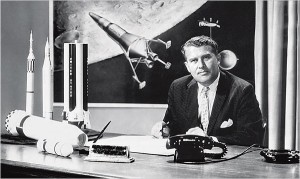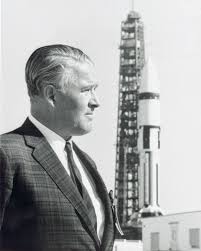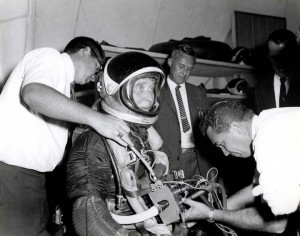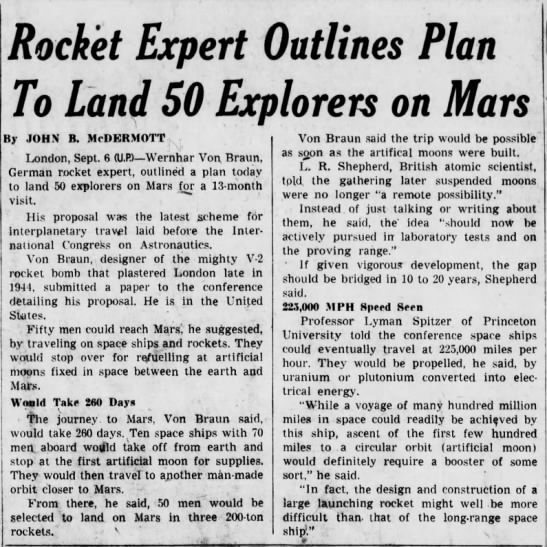Muammar Gaddafi got exactly what he deserved, but most don’t. Case in point: Wernher von Braun, complete Nazi and celebrated American hero, who was rescued from cosmic justice at the end of WWII by an accident of geopolitics. Hitler’s rocketeer knew as much about blasting off without blowing up as anybody at just the moment when the U.S.A. and the Soviet Union both wanted to rule the air, the Space Race on the horizon. He was deemed necessary and his slate wiped clean. An article by John B. McDermott in the September 6, 1951 Brooklyn Daily Eagle laid out von Braun’s plans for a nuclear-powered mission to Mars.
London–Wernher von Braun, German rocket expert, outlined a plan today to land 50 explorers on Mars for a 13-month visit.
His proposal was the latest scheme for interplanetary travel laid before the international Congress on Astronautics.
Von Braun, designer of the mighty V-2 rocker bomb that plastered London late in 1944, submitted a paper to the conference detailing his proposal. He is in the United States.
Fifty men could reach Mars, he suggested, by traveling on space ships and rockets. They would stop over for refuelling at artificial moons fixed in space between the earth and Mars.
Would Take 260 Days
The journey to Mars, Von Braun said, would take 260 days. Ten space ships with 70 men aboard would take off from earth and stop at the first artificial moon for supplies. They would then travel to another man-made orbit closer to Mars.
From there, he said, 50 men would be selected to land on Mars in three 300-ton rockets.
Von Braun said the trip would be possible as soon as the artificial moons were built.
L.R. Shepherd, British atomic scientist, told the gathering later suspended moons were no longer “a remote possibility.”
Instead of just talking or writing about them, he said, the idea ‘should now be actively pursued in laboratory tests and on the proving range.’
If given vigorous development, the gap should be bridged in 10 to 20 years, Shepherd said.
225,000 MPH Speed Seen
Professor Lyman Spitzer of Princeton University told the conference space ships could eventually travel at 225,000 miles per hour. They would be propelled, he said, by uranium or plutonium converted into electrical energy.
“While a voyage of many hundred million miles in space could readily be achieved by this ship, ascent of the first few hundred miles to a circular orbit (artificial moon) would definitely require a booster of some sort,” he said.
“In fact, the design and construction of a large launching rocket might well be more difficult than that of a long-range space ship.”•





